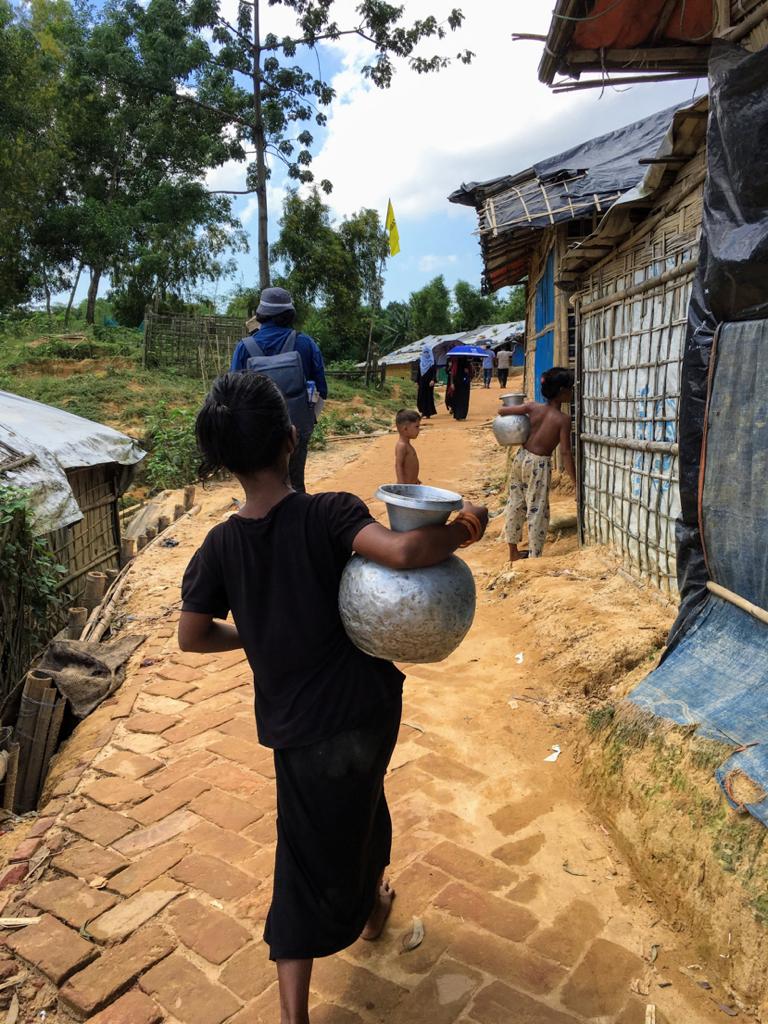
An article exploring the water challenges facing Rohingya refugees in the camps of Cox’s Bazar, Bangladesh, has been published today by the journal Sustainability. It was written by Mehereen Akhter, Sayed Mohammad Nazim Uddin and Nazifa Rafa (Asian University for Women (AUW)), Sanjida Marium Hridi (University of Victoria), and Chad Staddon and Wayne Powell (International Water Security Network, UWE Bristol).
Since August 2017, around 671,500 Rohingyas have fled ethnic cleansing in Myanmar to seek refuge in Bangladesh. The majority of these refugees are living in very fragile conditions in 34 densely populated camps in the Ukhiya and Teknaf Upazilas (subdistricts) of Cox’s Bazar.
The camps are overcrowded, with an average population density of less than 15m2/person, well below the international guideline of 30-45m2/person for refugee camps. There are problems with the quality and uneven distribution of water, with many people walking long distances to water sources. A 2019 report on the challenges facing Rohingya refugees highlighted inadequate sanitation facilities and the lack of safe and adequate water supplies. Cholera, typhoid, and diarrhea, particularly Acute Watery Diarrhea (AWD), is very common among the refugees. Over 64,000 cases of AWD were reported in April 2019 alone, among which over 40% involved children under five.
Against this backdrop, the global COVID-19 pandemic raises further concerns: if handwashing with soap is one of the key COVID-19 prevention strategies, it is crucial to address the water needs of refugee populations, for whom frequent handwashing may not always be easy or possible. Tackling the problems of water provision in refugee settlements is necessary not just for the immediate threat of COVID-19, but will be beneficial long-term, providing the refugees with safe water and inhibiting the outbreaks of waterborne diseases.
 Water, both at source and storage, has been found to have high levels of contamination. One study analyzed 12,650 drinking water samples from the camps and found fecal contamination in 28% of the source samples and in 74% of the storage samples. Similar results were obtained from a government study. This suggests that the high population density in the camps, along with inadequate hygiene practices, is resulting in secondary contamination of drinking water during collection, transportation, and storage. Although 97% of respondents surveyed by the AUW team said they cleaned their water containers every day, they did not always use soap, which is the most effective way to kill pathogens. At water collection points, it was observed that people tend to rinse the container and clean it by rubbing their hands around the inside. If these hands have not been washed with soap, this attempt at hygiene could contaminate the water seconds after collection, which is otherwise coliform-free at source.
Water, both at source and storage, has been found to have high levels of contamination. One study analyzed 12,650 drinking water samples from the camps and found fecal contamination in 28% of the source samples and in 74% of the storage samples. Similar results were obtained from a government study. This suggests that the high population density in the camps, along with inadequate hygiene practices, is resulting in secondary contamination of drinking water during collection, transportation, and storage. Although 97% of respondents surveyed by the AUW team said they cleaned their water containers every day, they did not always use soap, which is the most effective way to kill pathogens. At water collection points, it was observed that people tend to rinse the container and clean it by rubbing their hands around the inside. If these hands have not been washed with soap, this attempt at hygiene could contaminate the water seconds after collection, which is otherwise coliform-free at source.
Responsibility for fetching drinking water falls disproportionately on women and girls. In 57% of the households who were questioned by the AUW team, women were the sole collectors of water, while in 15% of households it fell to women and girls. The hours lost collecting water could be spent on childcare, informal education, voluntary work, or other productive activities. Children as young as six were found to do water collections, severely impacting their education. They have to collect water during the daytime, since night brings dangers of sexual assault.
Another issue facing the camps is the inadequate distance between water sources and latrines. 40% of households reported a distance of less than 30ft, which is regarded as the safe minimum distance to prevent groundwater contamination by coliform bacteria. During the emergency phase of camp construction, many water points were installed too close to latrines, and had to be moved later. However, some tube wells remain within unsafe distances of latrines due to the shortage of space in the camps.
Summer in Bangladesh used to last from March to June, but weather patterns have changed in recent years, with the dry season extending into August, which is usually monsoon season. The longer summer heat combined with limited rainfall exhausts groundwater resources. With only sporadic rainfall since November 2018, the water table for the refugee population in Teknaf was critically lowered during 2019, and the lack of groundwater availability cost UNHCR up to $60,000 per month in transporting trucked water.
The collective efforts of numerous humanitarian agencies and the government of Bangladesh have tried to improve conditions for Rohingya refugees since their arrival. At present, the Department of Public Health Engineering (DPHE) in collaboration with UNICEF and Action Against Hunger work to manage, oversee, and prepare strategic response plans for all WASH elements in the humanitarian sector. However, the Rohingya population is still dealing with challenges arising from congested and unhygienic camp conditions, the lack of sufficient water and sanitation infrastructure, fecal contamination, and geographical limitations such as a shortage of land area and groundwater.
The full article – Drinking Water Security Challenges in Rohingya Refugee Camps of Cox’s Bazar, Bangladesh – is available here.
